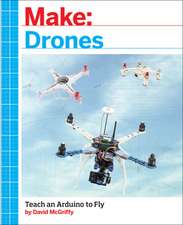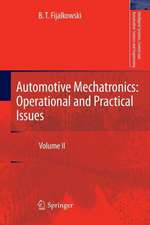Anti-personnel Landmine Detection for Humanitarian Demining: The Current Situation and Future Direction for Japanese Research and Development
Editat de Katsuhisa Furuta, Jun Ishikawaen Limba Engleză Paperback – 13 oct 2010
The JST adopted research proposals and the results are reported here. This book concentrates on aspects of three approaches to AP mine detection: enhancing and confirming the results of metal-detection scans using GPR; using robot vehicles and manipulators to operate within minefields remotely; and methods of sensing the explosives within mines.
Results are presented in the fields of GPR, nuclear quadrupole resonance, neutron thermal analysis and biosensors. The integration of these methods for workable robot operation is demonstrated. The project was carried out in conjunction with mine action centers in Croatia, Cambodia and Afghanistan. Evaluation data from field trials are also given.
| Toate formatele și edițiile | Preț | Express |
|---|---|---|
| Paperback (1) | 555.83 lei 38-44 zile | |
| SPRINGER LONDON – 13 oct 2010 | 555.83 lei 38-44 zile | |
| Hardback (1) | 644.18 lei 6-8 săpt. | |
| SPRINGER LONDON – 9 feb 2009 | 644.18 lei 6-8 săpt. |
Preț: 555.83 lei
Preț vechi: 694.79 lei
-20% Nou
Puncte Express: 834
Preț estimativ în valută:
106.37€ • 110.38$ • 88.91£
106.37€ • 110.38$ • 88.91£
Carte tipărită la comandă
Livrare economică 14-20 martie
Preluare comenzi: 021 569.72.76
Specificații
ISBN-13: 9781849968386
ISBN-10: 1849968381
Pagini: 236
Ilustrații: XXIV, 212 p. 196 illus., 25 illus. in color.
Dimensiuni: 155 x 235 x 12 mm
Ediția:Softcover reprint of hardcover 1st ed. 2009
Editura: SPRINGER LONDON
Colecția Springer
Locul publicării:London, United Kingdom
ISBN-10: 1849968381
Pagini: 236
Ilustrații: XXIV, 212 p. 196 illus., 25 illus. in color.
Dimensiuni: 155 x 235 x 12 mm
Ediția:Softcover reprint of hardcover 1st ed. 2009
Editura: SPRINGER LONDON
Colecția Springer
Locul publicării:London, United Kingdom
Public țintă
ResearchCuprins
Dual Sensor Systems Ground Penetrating Radar and Metal Detectors.- Principles of Mine Detection by Ground-penetrating Radar.- Development of Dual Sensors and Deployment in Mine Affected Countries.- Development of an Array Antenna Landmine Detection Radar System.- Test and Evaluation of Japanese GPR-EMI Dual Sensor Systems at the Benkovac Test Site in Croatia.- Vehicle Systems Based on Advanced Robotics for Humanitarian Demining.- Environment-adaptive Anti-personnel Mine Detection System: Advanced Mine Sweeper.- Humanitarian Demining Operation Using the Teleoperated Buggy Vehicle Gryphon with a Mine Sensors Equipped Arm.- Development of Mine Detection Robot Mine Hunter Vehicle (MHV), Controlled Metal Detector and Multi-functional Hydraulic Manipulator.- Explosive Sensors.- Nuclear Quadrupole Resonance for Explosive Detection.- Development of a High-performance Landmine Detection System Through Gamma-ray Detection by Using a Compact Fusion Neutron Source and Dual-sensors.- Development of a Compact Neutron Capture Gamma-ray Imaging System for Anti-personnel Landmine Detection.- Development of an “Electronic Dog Nose” Based on an SPR Immunosensor for Highly Sensitive Detection of Explosives.
Notă biografică
At present, Katsuhisa Furuta is Professor of School of Science & Engineering and School of Science and Technology for Future Life at Tokyo Denki University as well as Professor Emeritus of Tokyo Institute of Technology. He is to be the President of Tokyo Denki University from June 2008.
Professor Furuta’s research interests lie in the broad areas of System Control, Robotics, Mechatronics, and Computer Vision. He is has done pioneering research in the control of pendulums using the so-called Furuta Pendulum which has been used for control study and education in many countries. He received many awards including of Honorary Doctorate - Helsinki University of Technology (1998), IEEE CSS Distinguished Member (1998), and IEEE Third Millennium Medal (2000). He is a Fellow of SICE (1992), IEEE (1996), IET (2003), IFAC (2006), and Honorary Member of SICE (2006). He also served as Member of Science Council of Japan (1997-2003).
Professor Furuta’s research interests lie in the broad areas of System Control, Robotics, Mechatronics, and Computer Vision. He is has done pioneering research in the control of pendulums using the so-called Furuta Pendulum which has been used for control study and education in many countries. He received many awards including of Honorary Doctorate - Helsinki University of Technology (1998), IEEE CSS Distinguished Member (1998), and IEEE Third Millennium Medal (2000). He is a Fellow of SICE (1992), IEEE (1996), IET (2003), IFAC (2006), and Honorary Member of SICE (2006). He also served as Member of Science Council of Japan (1997-2003).
Textul de pe ultima copertă
There are more than 70 countries in the world that suffer from the presence of landmines. Annually, between 15,000 and 20,000 people are killed or injured by these mines so there is a pressing need for advances in technology to help to remove them.
Anti-personnel Landmine Detection for Humanitarian Demining reports on state-of-the-art technologies developed during a Japanese National Research Project. The conventional, and often reliable, method of landmine detection is to use a metal detector to pick up small amounts of metal within the mine. Unfortunately, minefields are frequently strewn with small metal fragments which can camouflage landmines greatly hindering progress using this form of demining. The challenge, then, is to develop practical detection systems that can discriminate between anti-personnel (AP) landmines and randomly scattered innocent metal fragments.
The results of 12 research proposals from universities and industrial sources and adopted by the Japanese Science and Technology Agency are presented here. This book concentrates on various aspects of three main approaches to AP mine detection:
• enhancing and confirming the results of metal-detection scans using ground-penetrating radar (GPR);
• using robot vehicles and manipulators to operate within minefields remotely; and
•methods of sensing the explosives within mines.
Basic results are presented in the fields of GPR, nuclear quadruple resonance, neutron thermal analysis and biosensors. The integration of these methods for workable robot operation is demonstrated. The project was carried out in conjunction with mine action centers in Croatia, Cambodia and Afghanistan and evaluation data from field trials of the technologies are also reported.
The results will be most useful to anyone who is involved in the use or production of technical equipment associated with landmine removal. In addition, academics researchingadvances in this field and those working in remote sensing, mechatronics and robotics will find much to interest them and a co-ordinated body of work with which to expand their own studies.
Anti-personnel Landmine Detection for Humanitarian Demining reports on state-of-the-art technologies developed during a Japanese National Research Project. The conventional, and often reliable, method of landmine detection is to use a metal detector to pick up small amounts of metal within the mine. Unfortunately, minefields are frequently strewn with small metal fragments which can camouflage landmines greatly hindering progress using this form of demining. The challenge, then, is to develop practical detection systems that can discriminate between anti-personnel (AP) landmines and randomly scattered innocent metal fragments.
The results of 12 research proposals from universities and industrial sources and adopted by the Japanese Science and Technology Agency are presented here. This book concentrates on various aspects of three main approaches to AP mine detection:
• enhancing and confirming the results of metal-detection scans using ground-penetrating radar (GPR);
• using robot vehicles and manipulators to operate within minefields remotely; and
•methods of sensing the explosives within mines.
Basic results are presented in the fields of GPR, nuclear quadruple resonance, neutron thermal analysis and biosensors. The integration of these methods for workable robot operation is demonstrated. The project was carried out in conjunction with mine action centers in Croatia, Cambodia and Afghanistan and evaluation data from field trials of the technologies are also reported.
The results will be most useful to anyone who is involved in the use or production of technical equipment associated with landmine removal. In addition, academics researchingadvances in this field and those working in remote sensing, mechatronics and robotics will find much to interest them and a co-ordinated body of work with which to expand their own studies.
Caracteristici
Will protect people from harm by helping to make the disposal of dangerous ordnance quicker and safer Presents state-of-the-art Japanese research in robotics and remote sensing from a co-ordinated consortium of academic and industrial sources Includes supplementary material: sn.pub/extras













